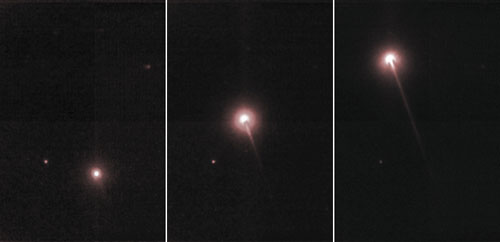 |
| Bow shock. These are the first images that show the shock
wave created as a meteor dives into the atmosphere. CREDIT: HANS STENBAEK-NIELSEN, UNIVERSITY OF ALASKA, FAIRBANKS |
This year's Leonids on 18 November 2001 dazzled viewers across the United States, when Earth zipped through a stream of debris from comet Tempel-Tuttle that orbits the sun. At times, more than 1000 meteors per hour streaked overhead. Geophysicist Hans Stenbaek-Nielsen of the University of Alaska, Fairbanks, captured one of those bright meteors with a high-speed camera that he uses to study auroras and the high-altitude electrical discharges called sprites. As part of an international campaign to study the Leonids, Stenbaek-Nielsen set up his camera in Poker Flat, Alaska. It snapped 1000 frames per second on an electronic chip that intensifies dim light.
The images were unveiled here 11 December at a meeting of the American Geophysical Union. Meteor astronomer Peter Jenniskens of the SETI Institute at NASA's Ames Research Center in Mountain View, California, who coordinated the campaign, says he was "blown away" by the sequence of photos. As long predicted, the meteor's initial pinprick of light spreads into a curved bow shock as it plows into the upper atmosphere at supersonic speeds of 71 kilometers per second. The bow shock sweeps back into the shape of an anchor, which grows perhaps 150 meters long--far larger than the walnut-sized meteoroid and longer than researchers expected.
Spectral measurements from other meteors suggest that temperatures within the shocked region reach 4000 degrees Celsius, Jenniskens says. The meteor's fragile organic molecules probably can survive that brief pulse of heat, he believes--making meteors one candidate for supplying Earth with the original ingredients of life.
The new images "make a significant contribution to our understanding of basic meteoroid phenomena," says aerospace engineer Iain Boyd of the University of Michigan, Ann Arbor. In particular, Boyd notes, the shape and surprisingly large size of the bow shock suggest that particles in the upper atmosphere strip molecules from the meteoroid and quickly form a cloud of hot vapor around it, creating the glow witnessed from the ground.
--ROBERT IRION
ScienceNow, December 17, 2001Related sites
The
NASA Ames Leonid campaign
Feature
article on Leonids by Peter Jenniskens
SETI
Institute